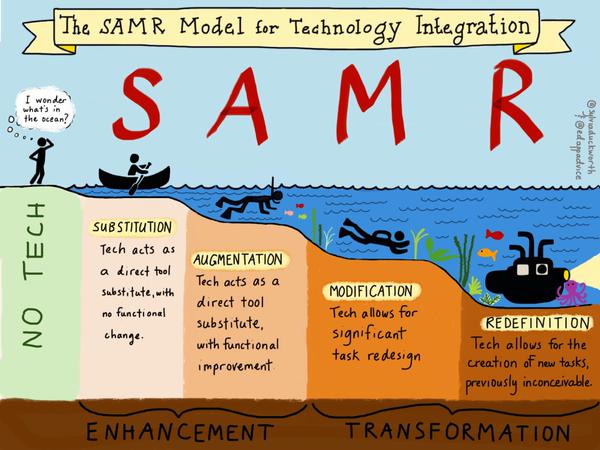“Include others in decision making. A class, group, or family can codevelop criteria for rules, or examine rules to understand what criteria were considered in making the rules. Safety, equity, and protecting the leaders may be some criteria used in the development of rules. What criteria are used to decide whether a source of information is credible can help others determine when to trust, and not, trust what they’ve heard.” (Wearing, 2022)
For my activity, I chose to have my students participate in Co-creating a rubric for a personal writing unit where they’re writing about a favorite memory. As part of Co creating the rubric, they were first presented with the provincial performance standards for grade 4 writing and the district single point rubric so they had samples of what others were thinking grade four students should be working on. Once we had had some time to explore the two sample rubrics together, I then broke my students into groups of three and had them working on our vertical non-permanent surface is. I use building thinking classrooms (Liljedahl, 2020) in most of my instruction very heavily in math I also use it a lot in social studies science and then often for the brainstorming phases of language arts activities. We followed the building thinking classrooms outline of having students standing in groups of three at vertical non-permanent surfaces and these are visually random groupings I typically use a random group generator on my computer that puts my students into groups of three. At this point, a month into the school year my students are used to our random groupings and that every time we go to the boards your group changes and that the computer decides who you are with this time.
Once in their groups I asked the students to discuss several questions together and to come up with what their answers were and record them on their vertical non-permanent surfaces. the first question I asked was what makes you want to continue reading a book when you pick it up and this really relates to the meaning of their writing. My second question was, what do you notice about the way authors use words in their writing and then this connects to the style aspect of a student’s writing. We continued to the third question that looked at form or how writing is organized, and this question was what do you notice about how authors organize their writing? And our final question was around conventions, and we discussed, what do you notice about how authors use spelling punctuation and grammar 2 make their writing easy to understand.
While the students were working at the vertical non-permanent surface is I had a wonderful opportunity to check in with my groups of three as well as with individuals and really discuss what they noticed about their favorite writing and their favorite stories things from they do something at the beginning to get my attention or they use interesting words and a lot of the discussion really centred around what was the author doing that got our attention and made us want to know more.
Once the students had had about 10 or 15 minutes in their groups working on their vertical non-permanent services we returned to our desks and shared out. Our first decision as a class was whether or not we wanted to continue using a four point rubric or with a single point rubric and after a bit of debate and discussion we did settle on using a single point rubric with students feeling like that was the most easily understood for them and that it gave them just one thing to focus on and they knew what a proficient piece of writing would look like. Then once we had chosen our style of rubric we went through each section and the students with teacher guidance and input determined and decided what we were going to be looking for in proficient good grade four writing.
For me having students involved in creating a rubric and Co creating assessment expectations was knew handed honestly felt a little bit risky. My students rose to the challenge and as with all activities some appeared more engaged than others and I definitely had a higher level of engagement in the process when students were working at their vertical non-permanent surface is an in their smaller groups our engagement in the process of making decisions together definitely declined when we returned to our desks. I’m wondering if our conversation may have been a bit more open had instead of going to desks I brought the students back to the carpet which is our gathering place and where we do a lot of our direct teaching most of our discussions, in my classroom our carpet is our gathering space I often early in the year compare it to a family’s dinner table where that is where we gather together that is where we can all be seated together in community. we use our carpet most of the day we are only at our desks if we are writing something or eating, our floor spaces and carpet are used for games and connecting and being together. So, I’m wondering if having students return to their desks while we Co created the rubric it last that sense of community that we have when we are having incredibly open discussion at the carpet. Looking ahead I think Co creating rubrics for assessments is something I would like to continue, but I think how I approach it how I set up the activity does need to be tweaked and that we really need to be having these discussions together as our class family in our gathering space. I also noticed that my students when co-creating the rubric were more focused on the conventions part of the rubric rather than the ideas in the meaning and form sections. This also guides me in my instruction as I am seeing that my students need more opportunity to develop their ideas and become comfortable discussing and sharing ideas.
Personal Writing Single Point Rubric – Student Generated
Name: ________________ Date:_________________ Assignment:________________
| Areas to Grow | Criteria | Areas that Glow |
| MEANINGI can…Write about something I have done or that I likeUse interesting or sensory detailsI can explain my ideas and opinions | ||
| STYLEI can…Use a variety of interesting wordsUse adjectivesWrite sentences that are smooth and make senseWrite sentences that start different waysWrite sentences that are different lengths | ||
| FORMI can…Put things in an order that makes senseUse a hook to get my reader’s attentionStay on topicChoose ideas and details that are connected to the topicUse connecting wordsWrite an ending | ||
| CONVENTIONSI can…Use end punctuation at the end of a sentence (.!?)Use commas and quotation marks in the right spotUse capitals for the first word in a sentence, I and the names of people or placesUse complete sentencesSpell the no excuse wordsSpelling mistakes do not take away from the meaning |
Bibliography
Liljedahl, P. (2020). Building Thinking Classrooms in Mathematics, Grades K-12: 14 Practices for Enhancing Learning. Corwin.
Wearing, J. (2022). TEACHING STRATEGIES FOR CRITICAL THINKING LEARNING ACTIVITIES. Retrieved from Faculty of Education Queen’s University: https://onq.queensu.ca/content/enforced/56140-PME-833/Module%202%20Teaching%20Strategies%20for%20Critical%20Thinking%20Learning%20Activities.pdf?ou=56140


